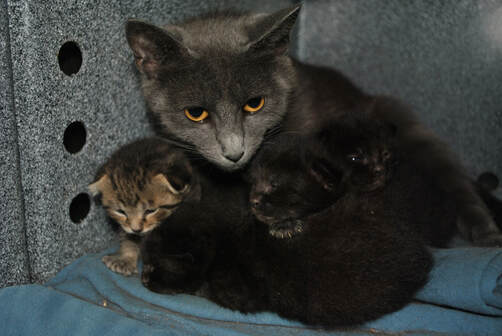What to do if You Find Feral Kittens

It is common, especially during kitten season, to find a litter of unattended kittens, or a seemingly orphaned kitten by itself. Chances are, however, that momma cat is somewhere nearby. She may be watching from a distance, or off searching for food. It is not uncommon for a momma cat to leave her kittens alone for several hours. If you find a kitten alone, she may be in the process of moving her litter from one location to another.
Although it may be tempting to jump in and help, take the following steps before doing anything.
1) Assess the kittens’ apparent health.
2) Assess the environment.
3) After assessing the situation, if you determine that the kittens are healthy and in a safe location, it is best to wait and watch to see if the momma cat will return. You should stay at least 35 feet away, but the farther the better. Do not place food near the kittens to try to entice the mother to return. She almost always hides her litter away from food sources to protect them from other cats or predators.
In some cases you may need to leave the area completely and check back in 4-6 hours to see if the kittens are still OK. Especially if momma cat is feral, she will most likely not return until she no longer senses the presence of humans. In this case, you can sprinkle a line of flour (or another visible, cat-safe substance like small twigs) around the kittens' nest to see if it is disturbed when you return. If it is, and the kittens are otherwise in roughly the condition you left them, they're probably fine and are being cared for. Keep in mind that healthy kittens can survive several hours without food as long as they are warm. Hypothermia is a much greater risk than starvation for neonatal kittens.
Although it may be tempting to jump in and help, take the following steps before doing anything.
1) Assess the kittens’ apparent health.
- Does their fur look healthy, full, and fluffy? Or are they dirty and look sickly?
- Are they sleeping quietly? Huddled together? Or are they crying?
- Are they dry, or wet?
2) Assess the environment.
- Are the kittens in immediate danger from rain, wet weather, or the cold?
- Are there potential predators around, such as raccoons or dogs?
- Is there nearby traffic, like pedestrian foot traffic, bicycles or cars?
3) After assessing the situation, if you determine that the kittens are healthy and in a safe location, it is best to wait and watch to see if the momma cat will return. You should stay at least 35 feet away, but the farther the better. Do not place food near the kittens to try to entice the mother to return. She almost always hides her litter away from food sources to protect them from other cats or predators.
In some cases you may need to leave the area completely and check back in 4-6 hours to see if the kittens are still OK. Especially if momma cat is feral, she will most likely not return until she no longer senses the presence of humans. In this case, you can sprinkle a line of flour (or another visible, cat-safe substance like small twigs) around the kittens' nest to see if it is disturbed when you return. If it is, and the kittens are otherwise in roughly the condition you left them, they're probably fine and are being cared for. Keep in mind that healthy kittens can survive several hours without food as long as they are warm. Hypothermia is a much greater risk than starvation for neonatal kittens.

If momma cat returns and you’ve determined the area is relatively safe, leave the kittens alone until they are weaned at approximately 5-6 weeks. You can monitor the area from a distance and offer shelter and food, but keep the two apart from one another. Mom won’t use the shelter if food is nearby, and if your presence becomes too intrusive to her, she will relocate.
FIX THE FAMILY: Once the kittens are old enough, you can trap them, along with mom, so that they can be seen by a veterinarian, socialized, spayed/neutered, and hopefully adopted.
Remember, it is also extremely important that you trap the momma cat as well and take her in to be spayed so that she will not continue to give birth to litters on the streets.
FIX THE FAMILY: Once the kittens are old enough, you can trap them, along with mom, so that they can be seen by a veterinarian, socialized, spayed/neutered, and hopefully adopted.
Remember, it is also extremely important that you trap the momma cat as well and take her in to be spayed so that she will not continue to give birth to litters on the streets.
If the Mama Cat Does Not Return
In the event that momma cat does not return and it becomes apparent that the kittens are in need of human intervention, it is important to follow certain steps.
1) You should remove the kittens as soon as possible, as it is crucial to their survival. However, you must also be prepared to provide them with the care they need to thrive.
2) Make sure the kittens are kept warm and safe in their "nest", which is typically a box or carrier. Very young kittens can't regulate their own body temperature, so you'll need to create a warming center in a quiet, isolated location. Be equally sure that they can move away from the heat source if they become too warm, to prevent overheating.
3) It is also important that you quickly take the kittens to a vet for a wellness checkup.
4) Feeding orphaned kittens requires a special formula called kitten replacement formula. It is important not to simply feed them any other types of milk. In their first week of life, kittens must be fed every two hours. Between one and two weeks, they can be fed every two to three hours. At two to three weeks of age, they can be fed every three to four hours. At three to four weeks, they should be fed every four to five hours. At four to five weeks, they can be fed every five to six hours, and at five to eight weeks every six hours. At this time they will also begin to wean, so in addition to bottle feeding you should provide them with ample wet food.
In addition to these frequent feedings, the kittens will need to be manually stimulated to encourage elimination. They will also need to be cleaned as their mother would clean them.
***Click here for more in-depth instructions***
In the event that momma cat does not return and it becomes apparent that the kittens are in need of human intervention, it is important to follow certain steps.
1) You should remove the kittens as soon as possible, as it is crucial to their survival. However, you must also be prepared to provide them with the care they need to thrive.
2) Make sure the kittens are kept warm and safe in their "nest", which is typically a box or carrier. Very young kittens can't regulate their own body temperature, so you'll need to create a warming center in a quiet, isolated location. Be equally sure that they can move away from the heat source if they become too warm, to prevent overheating.
3) It is also important that you quickly take the kittens to a vet for a wellness checkup.
4) Feeding orphaned kittens requires a special formula called kitten replacement formula. It is important not to simply feed them any other types of milk. In their first week of life, kittens must be fed every two hours. Between one and two weeks, they can be fed every two to three hours. At two to three weeks of age, they can be fed every three to four hours. At three to four weeks, they should be fed every four to five hours. At four to five weeks, they can be fed every five to six hours, and at five to eight weeks every six hours. At this time they will also begin to wean, so in addition to bottle feeding you should provide them with ample wet food.
In addition to these frequent feedings, the kittens will need to be manually stimulated to encourage elimination. They will also need to be cleaned as their mother would clean them.
***Click here for more in-depth instructions***
Taking in young kittens is a big commitment and requires a tremendous amount of care and attention. If you feel you are not capable of providing them with the care that they need, you can try contacting your local animal shelters to see if they have any available volunteers to take the kittens in.
Once you have decided to intervene, you have become responsible for the care of these kittens, so it is important to be educated and prepared to provide them with the time, attention, and care that they need.
Once you have decided to intervene, you have become responsible for the care of these kittens, so it is important to be educated and prepared to provide them with the time, attention, and care that they need.